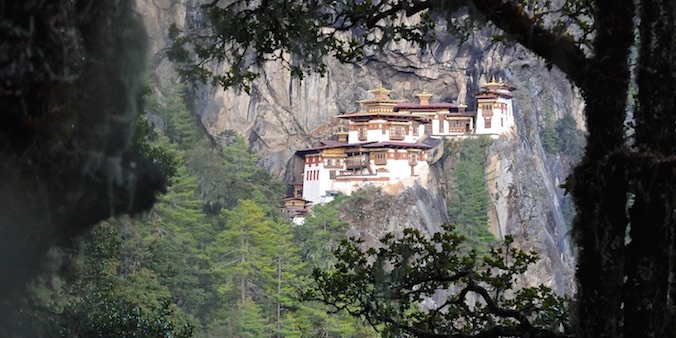THE ESSENCE OF BHUTAN
Tour - 13 days
The Essence of Bhutan
Tour - 13 days
About BHutan
Bhutan is not your average destination. And that’s the understatement of the century. For starters, it’s the only remaining Buddhist Himalayan kingdom, the only one that managed to escape assimilation by either China or India. Being only the size of Switzerland and having just over 700,000 inhabitants, that’s quite a feat in itself.
Bhutan is mainly known for its very original culture and nature. This is largely due to the centuries of isolation, but also to the deliberate policies of the present government and of the kings in the past. Until the seventies, hardly any foreigner ever had set foot in the secluded kingdom.
Read more…Read less…
HAPPINESS OVER WEALTH
However, in 1972, at the occasion of the crowning of king Jigmed Singye Wangchuk, many foreign guests were invited to Bhutan. Having studied in the U.K., the future king obviously saw it coming that especially the western guests would observe a discrepancy between their own standard of living and that of the Bhutanese. In his opinion, the Bhutanese were not poor, but merely lacking in some amenities and products available in the West, most of them non-essential. Otherwise, the Bhutanese were actually quite well off, he felt. Almost all of them had a beautiful, spacious farmhouse, more than enough forests, arable land and animals to be fully self-sufficient in terms of heating, construction and nourishment. And, most importantly, a culturally defined sense of identity, belonging and security that made most of them very content and happy beings. The king had observed otherwise in the west.
In order to explain this to his foreign guests, he coined the term ‘gross national happiness,’ a clever term obviously meant to be juxtaposed with what seemed to be the aim of most governments, a high gross national product. The rest is history, one could say. These days, all over the world, conferences and workshops are being held on happiness and, more in general, on how to develop and emphasize those qualities of life that can not be measured in dollars or euros.
Bhutan does not claim that its inhabitants are the happiest in the world, but it does place overall happiness above wealth. These days, GNH, as it is generally referred to, is the formal pillar and yardstick of all government policies. After the king abdicated his powers in favor of a democratically elected government, Bhutan has seen four governments. All of them have continued to place GNH above anything else.
As a result, Bhutan has protected its culture – largely defined by Buddhist beliefs – but also its forests, mountains, rivers and wildlife much better than any other country in Asia. Key to all this is a reliable, non-corrupt government, which itself is one of the four pillars of GNH and, frankly, quite the exception in the region.
On your trip through Bhutan you will see numerous temples, monasteries and dzongs (monastery castles), better preserved and more lavishly decorated than anywhere else in the ‘Tibetan’ realm. Not less impressive, if alone because of their rustic beauty, are the many traditional houses, as well as meeting the friendly, warm-hearted people who embrace their culture as a precious heritage.
Read more…Read less…
Bhutan is also extremely mountainous and rich in nature, especially forest – in fact, it is the most wooded country in Asia. The southern border consists of hills and low mountains with dense jungle where elephants and tigers roam, and people live in bamboo houses surrounded by rice fields. But in the central highlands, at an altitude of 1500 – 2500m, people live in small enclaves of farms reminiscent of Swiss chalets, surrounded by endless coniferous forests. Travelling through this area (and when you fly over it) you will occasionally catch a glimpse of the northern and highest parts, where the semi-nomadic yak shepherds live and which are bordered by glacier-covered Himalayan peaks. The only way to see all this up-close is to set out on a seven-day (or more) camping trek.
Region
Butan
Best Time
March - May & Sept. - Nov.
No. Of Days
13 days
Trip Character
Jeep tour
Sleeping Altitude
1400 - 2900 m
Price
INR XXX/ $ XXX
ABOUT THIS TOUR
On this journey, you will explore the western and central part of Bhutan and get immersed in the all-encompassing otherness that defines this country. Bhutan is not a country to rush through, as the essence of the Bhutanese way of life is contentedness with all the good things that life brings. In Bhutan there is no such thing as missing something in life – or on a trip.
So, on this tour, we take our time to explore the charming little towns of Paro, Haa and Punakha, immerse in the mythical atmosphere of a medieval temple, be awe-struck by the massive dzongs – temple boroughs – feel our jaws dropping at the unbelievable marksmanship at an archery contest, and try not to panic as your tongue catches fire while trying the signature dish of Bhutan, emma datzi, the first time.
Read more…Read less…
After arrival at the international airport at Paro, we take you straight to Thimphu. Here, in the most relaxed capital in the world, you will have almost two days to explore its many sights.
Then you’ll travel eastwards, in stages. First, to the former capital Punakha, with its magnificent dzong, and then via the idyllic Phobjikha Valley, home to Bhutan’s national bird, the black-necked crane, to Bumthang, located in the ‘middle east’ of Bhutan.
Bumthang is the cultural ‘heartland’ of Bhutan. Here you have two full days to explore the many temples, monasteries and palaces, largely on foot. You then fly back to Paro with a domestic flight, on which you can expect great views of the Himalaya. After landing we take you straight to the quiet Haa Valley, on the way crossing the highest car pass in Bhutan.
Back in Paro you’ll do the almost compulsory walk to famous Taktsang Goemba. This iconic monastery (also called Tigers’ Nest) is stuck to the rocks like a swallow’s nest and can only be reached on foot.
On this trip, there is ample opportunity for short or longer walks in various places. These are always optional, and can be planned in consultation with the guide. There is always an alternative program, also for the walk to Taktsang.
And, if possible, you’ll witness a tsechu (traditional Buddhist festival). Just give us your preferred travel dates and we’ll try to fit one in.
YOUR custom-made TRIP
The tour described here, as well as the other ones on our website, are mainly meant as suggestions. We would be happy to offer you a travel proposal that fully meets your personal demands and expectations. That means that you choose where you want to go, what level of accommodation and type of transport you want and what activities you prefer.
Please let yourself be inspired by this and other trips on our website and then drop us a line (or call us) to explain your travel wishes. We will be happy to help you put together the perfect trip. You can reach us over e-mail, Messenger, Whatsapp or mobile phone.
EXTENSIONS & VARIATIONS
Apart from the tour as described here, you could consider the following add-ons and changes:
- Spend another day in Thimphu, for instance at the end of the tour. Because, although Thimphu is by far Bhutan’s most ‘mundane’ place, it has a lot to offer in terms of culture, restaurants and cafes, shopping, and a very pleasant atmosphere.
- Do a short trek which takes of the beaten track, along time-warped villages and high yak pastures. For instance a two-day trek in Bumthang, from Jakar to Tang and over de Phephe La (pass) to Nang Lhakhang. Or the three-day Saga La Trek from Haa upto the Che La pass. On longer treks (seven days minimum) you can get up-close with the Himalayan giants, such as Mt. Jhomolhari (7326m). For the latter, see here.
- Spend a day rafting on the Punakha River. There are different grades available, so there is the easy-but-fun-to-do level as well. Professional oarsmen will be with you in any case. You will be picked up from your hotel and dropped off there again at the end of the day, a pic-nic lunch is included.
ITINERARY
-
.fa-info {color: #1146a9;}.fa-info:hover {color: #387dff;}Day 1: Delhi ✈︎ Paro & drive to Thimphu (1.5 h)
The flight to Paro (Bhutan) takes less than 2,5 h and, in clear weather, affords wonderful views of the Himalayas, including Mt. Everest (8848m) and Kangchenjunga (8568m). At the airport our guide and driver await you outside the airport, and will take you to Thimphu, the capital. On this short drive, you'll get a first glimpse of Bhutan's forests and rustic, half-timbered houses. Altitude 2350m. a:hover {color: #1146a9; background-color: transparent; text-decoration: underline; } -
Day 2: In Thimphu
You have the whole day to explore Thimphu. Besides the many options listed in the highlights below, you can visit the archery range and the animal park with the takin, the national animal of Bhutan. Or you can walk to a nearby monastery in the woods with beautiful views. Altitude 2350m. -
Day 3: Thimphu - Punakha (2.5 h)
Driving eastwards over the only road that connects the capital with middle and East of Bhutan you'll cross the 3120m high Dochu La (‘La’ = ‘pass’). Here, you get beautiful views of the Himalayas, before descending to the relatively warm Punakha valley. Altitude 1400m. -
Day 4: In Punakha
Today, you'll explore several sights of Punakha, most importantly Punakha's magnificent dzong. Altitude 1400m. -
Day 5: Punakha - Phobjikha (3 h)
Traveling further to the east, you reach the beautiful, high valley of Phobjikha. Altitude 1400 → 2900m. -
Day 6: In Phobjikha
Phobjikha is a protected conservation area where black-necked cranes live. On a walk through the valley you hopefully will see the cranes. And you visit Gangte Goemba (goemba=monastery), belonging to the Nyingmapa, the oldest Buddhist sect in Bhutan and Tibet. Altitude 2900m. -
Day 7: Phobjikha - Bumthang (5.5 h)
Driving up to the Pele La (3425 m, la=pass) you get a good impression of the extend and denseness of Bhutan’s forests. You pass the chörten of Chendebji, Trongsa with its prominent dzong and the very picturesque Chumi valley. Altitude 2900 → 3425 → 2180 → 3420 → 2585m. -
Day 8: In Bumthang
In terms of Buddhist cultural heritages, there is no place like Bumthang. In consultation with the guide you can decide which ones of the many temples you want to visit. Altitude 2585m. -
Day 9: Bumthang ✈︎ Paro - Haa (30 min flight, 2.5 h drive)
A short but spectacular flight takes you back to Paro. In 30 minutes, the entire journey of the past few days will pass under you, with wonderful views of the glaciated peaks of the Himalayas on the north. Crossing the almost 4000m high Chele La (by car) you'll reach the idyllic Haa valley. Altitude 2580 → flight → 2250 → 3990 → 2670m. -
Day 10: In Haa
Today you'll take several short walks in the countryside, visiting rustic villages and climbing up to small, hidden monasteries. -
Day 11: Haa - Paro
Today you return to Paro via a different route, one of Bhutan's most scenic drives. The afternoon can be spent on visiting pleasant centre of Paro, the dzong and adjacent National Museum or maybe the medieval Kyichu Lhakhang (lhakhang=temple). Altitude 2670 → 2250m. -
Day 12: in Paro, walk to Tigersnest
Today you do the well-known hike to legendary Taktsang Goemba, better known as Tiger’s Nest. It is 2.5 h walking up and 1.5 h down, but the magical little temple is worth it. Altitude 2250 → 3120 → 2250m. -
Day 13: Paro ✈︎ Delhi
A morning flight brings you from Paro to Delhi, hopefully again with wonderful views of the Himalayas. If you have asked us to arrange accommodation and transfers in Delhi you will be picked up form the airport by our driver.
HIGHLIGHTS OF THIS TOUR
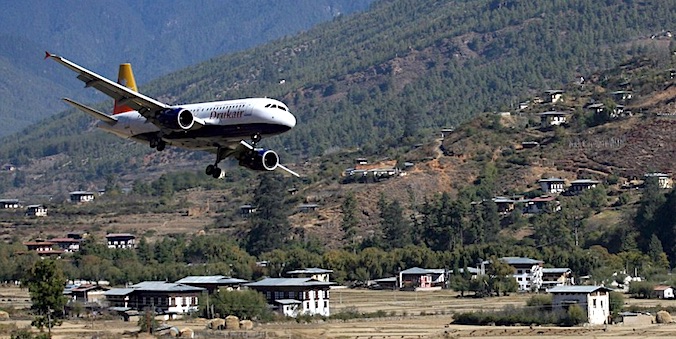
Flight to Paro
Paro
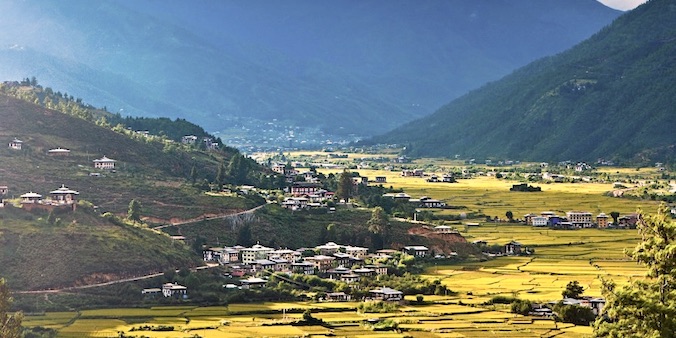
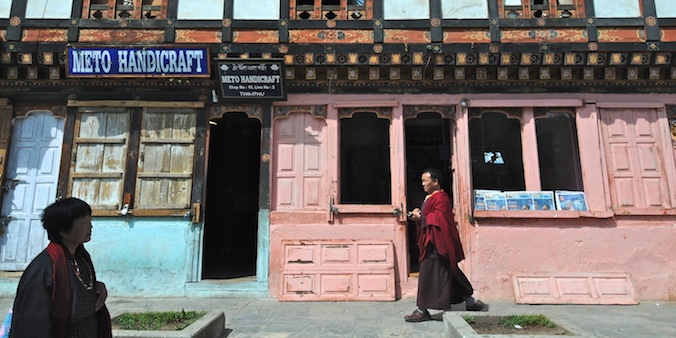
Thimphu
Sights of Thimphu
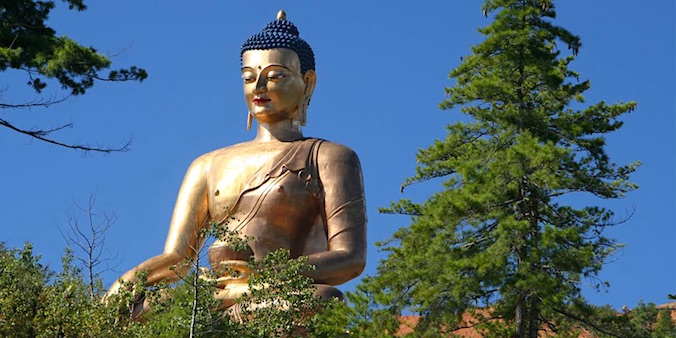
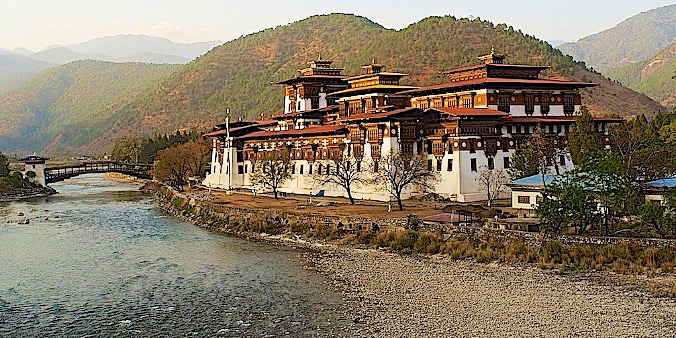
Punakha Dzong
Punakha - Other Sights
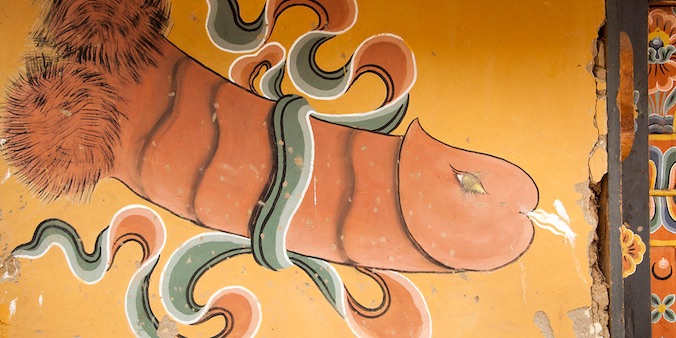
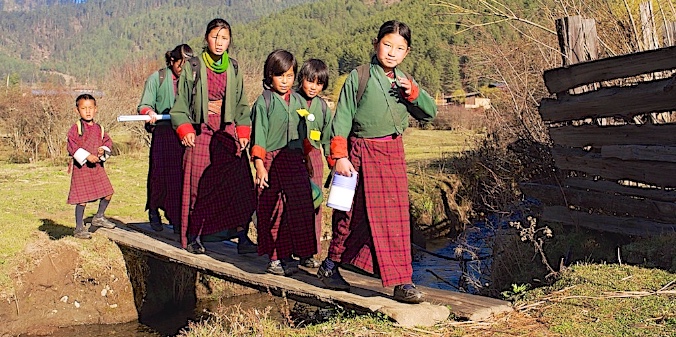
Phobjikha
Walks at Phobjikha
Phobjikha is not just a protected area, it is walkers paradise as well. Th three main valleys that converge near Gangte, where you will stay, offer gently sloping mountain sides with meadows and forests teeming with birds, interspersed with small hamlets of traditional farms. On the day you’re leaving Phobjikha, you’ll be offered the option of trekking rather than driving out. In case you are traveling west, you climb and then cross a pass to the northeast. You’ll get splendid views of Trongsa Valley, and, wheather permitting, of the Great Himalayan Range. After descending down to the road, the car will pick you for the onward journey. If you’re traveling west, you can take a similar walk, crossing a pass and descending through a magnificent rhododendron forest to the road to Punakha.
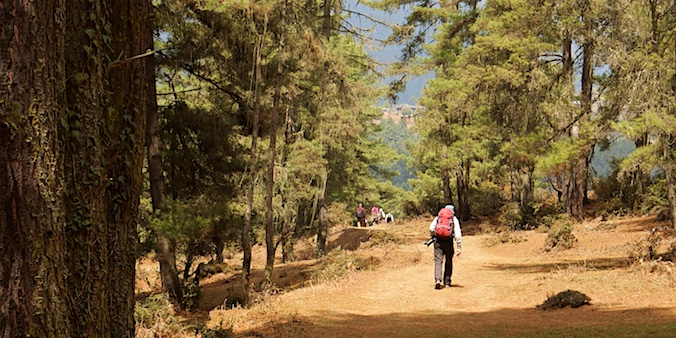
Trongsa Dzong
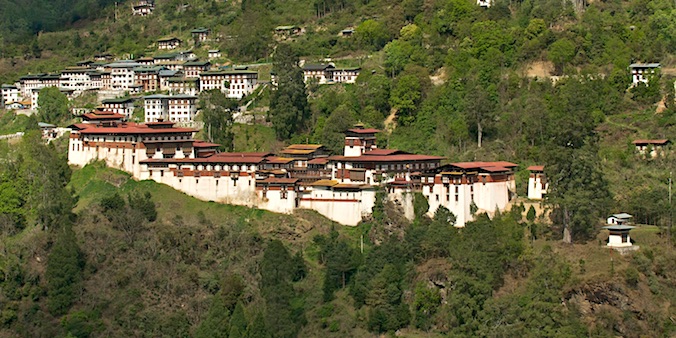
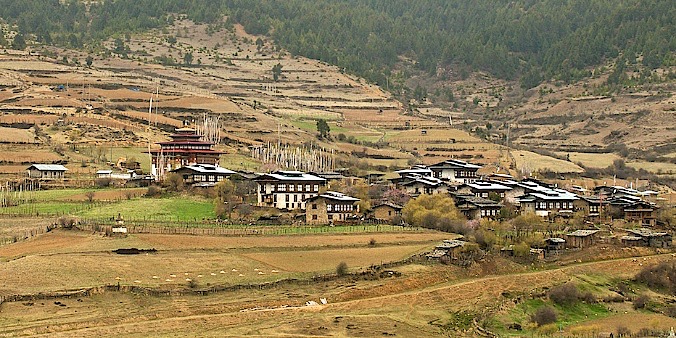
Bumthang
Temples of Bumthang
From your lodge in Jakar you can visit several beautiful temples on foot. Jambey Lhakhang is one of the oldest and most atmospheric temples in Bhutan. This temple, dating back to 659, was part of the project of the then Tibetan king to build 108 temples in order to nail down a giant demones that threatened the entire Tibetan cultural sphere. The main inner temple is dedicated to the Buddha of the future. It has three steps, the first one, representing the past, has already sunk into the ground, the second (present) is at floor level. When the third, raised one (the future) will have sunken into the ground the end of times will be there… At the Kurjey Lhakhang a wonderful print of Padmasambhava’s body can be seen. You cross the river via a suspension bridge to Tamshing Goemba (monastery) with its beautiful 17th century murals.
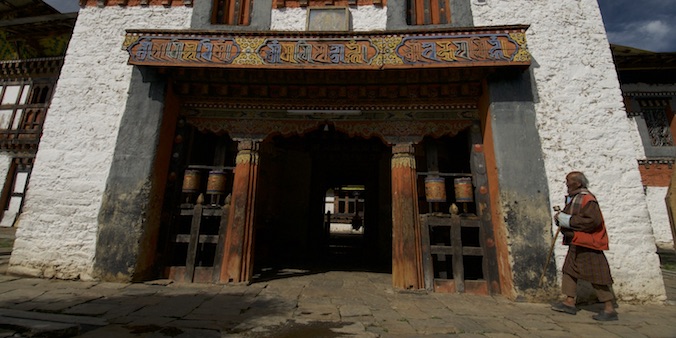
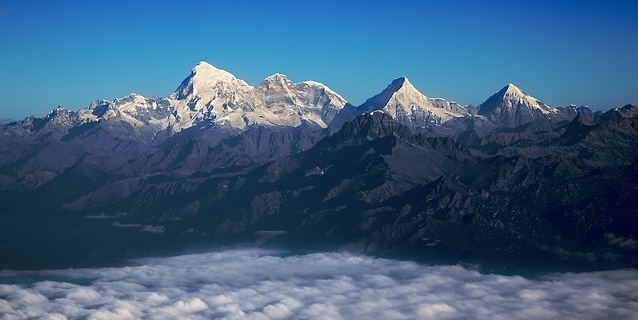
ROAD to HAA over CHELE LA
From the Paro Valley you climb to Bhutan’s highest motarable pass, the Chele La (3988m). The narrow road creeps up through magnificent forests of enormous cedars, spruces and larches, a well as tree-high rhododendrons (which normally bloom in April-May). Once up, weather permitting, you will be treated to beautiful views of the Himalayas, especially Mt. Jhomolhari (7329 m) right on the Tibetan border. The best view you get from the road, 100 m north of the pass. Descending, you reach the green-forested Haa Valley. It can be chilly here in the evening, but the wood stove in the resort is always on.
HAA
Although the flight takes only one hour, on a clear day this no doubt is one of the most spectacular flights in Asia. After leaving the North-Indian plains and the heavily forested hills you’ll cross a number of ranges before flying over the actual glacier-clad Himalayas, the highest mountain range in the world. You’ll be amazed at the different landscapes you’ll see beneath you on the other side: bare, lightly coloured mountains, tiny rivers, small hamlets of Ladakhi farms surrounded by deep-green fields of barley, made possible by ingenious forms of irrigation.
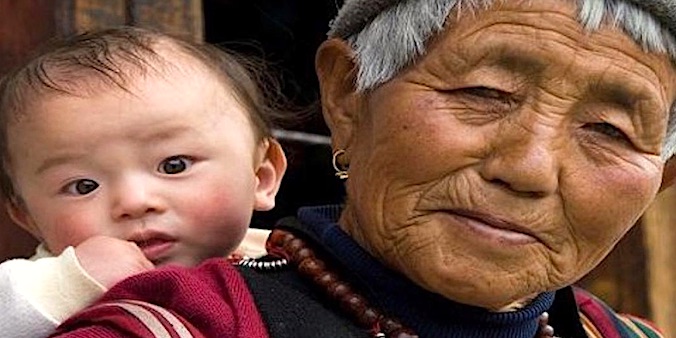
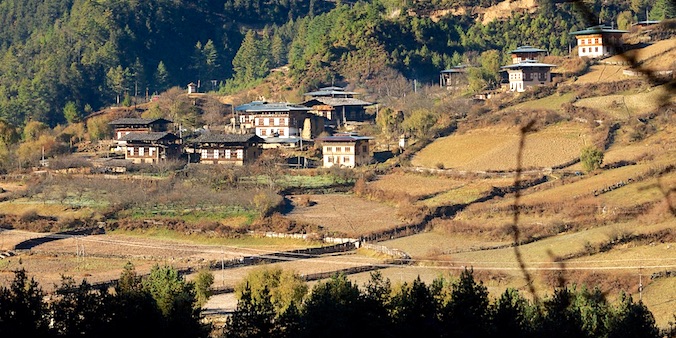
Road HAA - CHUZOM
